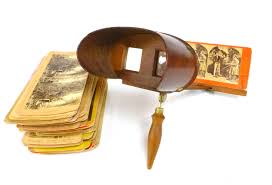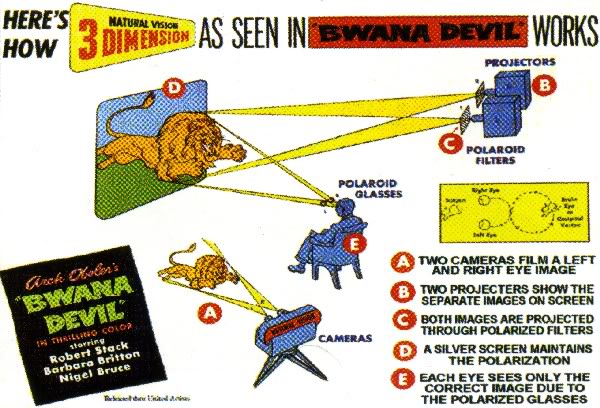by Gary Meyer
My college thesis proposed a cinema inside a bubble—everywhere the audience looked there were images; surround sound added to the experience, as did wind and even a misty spray when appropriate. Cinema entrepreneurs have employed elements of this idea, and you will discover many of them here.
Everywhere You Look
If only we could go back in time to 1900 in Paris and try Cinéorama, with 10 synchronized 70mm movie projectors projecting on a full circle screen while we stand in a large hot air balloon basket and feel that we are floating above France. Some drawings indicate there might have been movement to simulate the balloon riding the winds, but few people actually experienced it, as the projectors created so much heat that the fire department shut the show down immediately.
Luckily, Disneyland introduced a modern version, Circle-Vision 360°. As a teen I remember the motion effect made me hold the handrails to prevent falling down. The theater was not moving but being fully surrounded by the action caused the eyes and brain to fool the body.
Bigger Than Life
As a teen I was lucky enough to try the many formats at Expo ‘67 in Montreal. Passionate to learn all I could about movies, I went from one pavilion to the next over a week, seeing unimaginable screen shapes and concepts, truly the future of cinema and much of it yet to be matched. There were screens above and below and all around me. Filmmakers had free reign to experiment. Circle-Vision 360° was there, with a film Disney produced about Canada. A Place to Stand was projected on a huge 70mm screen, with dozens of moving images morphing into kaleidoscopic montages. The film later was released to regular theaters and won an Oscar. No mater how many times I saw it, I couldn’t keep up with the visual overload. Unfortunately, the ear-worm theme song never goes away: “Ontar-i-ar-i-ar-i-ooo.” We Were Young was an experimental exploration of youth exploding on the cultural scene with new music and lifestyles. Projected on three large adjacent square screens topped by three oblong ones, it was a stimulating piece that probably alienated many “adults.” In Citérama there were two moving platforms—an upper and a lower one—with seats carrying audiences through a montage of over 700 images and an early version of many-channel surround sound. Kaleidoscope was purely experimental, as we moved through three different theaters offering many images projected on mirrors, creating an infinity effect.
The Labyrinth was a three-part experience. In the first chamber, two films were projected simultaneously, one on the wall opposite where we stood, and the other on the ground below, with the action on each screen interacting. A father looking down at his child, for example. The second room was a maze of tiny lights leading us to a conventional cinema setting, but a powerful film projected onto five screens in the form of a cross.
The Czech Kino-Automat allowed the audience to decide what direction the narrative would take in a short black comedy. Each seat had a pair of buttons and we could vote on which door a man might open or the decision a lady should make—though upon comparing notes with others who saw it (as well as my repeated viewings), the ending was always the same.
Time magazine called Montreal “Celluloid City,” writing, “Sometimes film flutters futuristically above or beneath [the visitor]; sometimes images lurk and flicker all around him, caroming off walls, whirring on blocks and prisms, on hexagons and cruciforms. Sometimes movies are even mounted on a plain old rectangular screen—but everywhere there is film, film, film unreeling.”
And it was so true. I was not alone in exiting Labyrinth and the Kino-Automat only to get back in a long line to see them again. To top it off, the Montreal International Film Festival was on the week I was there. I have to mention this because I found myself in a hotel lobby sitting with John Ford, Fritz Lang and Jean Renior, three of my cinema heroes. A lively conversation was being held in outrage about the local government banning Larry Kent’s new film High from the Festival.
 [More details about the Expo ‘67 films can be found below.]
[More details about the Expo ‘67 films can be found below.]
Several filmmakers, frustrated by technical problems with their films at Expo ’67, joined forces to build a single-projector large screen format called IMAX. The first film was demonstrated at Expo ’70 in Osaka, Japan and the first permanent IMAX theater opened in Toronto the following year. The installations were initially at expos, museums and science centers, with the films usually lasting 20 to 40 minutes and educational in content—following nature around the globe, under the sea and going into space with NASA. Some dome theaters were built for a planetarium effect that got mixed reactions.
While I have ridden a glass elevator at the Rex Paris behind its massive screen during a screening, what is considered the largest movie screen in the world at the Sidney, Australia IMAX is on the bucket list- a mere 97 feet high and 117 feet wide.
Now Dolby has announced a new direction with Dolby Cinema to challenge IMAX.
According to The Hollywood Reporter:
“Dolby Cinema will include special design elements — like signature entrances that can be programmed to reflect the movie that is playing — as well as giant screens and, of course, Atmos sound. But what’s really piquing the interest of filmmakers is the system’s ability to project “high dynamic range,” a process in which whites appear whiter and blacks blacker. Gravity‘s Oscar-winning cinematographer Emmanuel Lubezki, for one, has said he’s eager to make use of HDR. In fact, many insiders from Hollywood’s technology community believe that consumers will see a noticeable difference with HDR, compared with the more widely touted “Ultra HD” 4K resolution and high frame rates.

Image courtesy of Corey A. Edwards.
Tommy Can You Hear Me?
Stereophonic sound was first demonstrated in Paris in 1881 when a series of telephone transmitters connected to the stage of the Paris Opera allowed listeners elsewhere in the city to listen to the performance live with a receiver for each ear. As opposed to Monophonic, a single channel, Stereo refers to two or more channels of audio to provide the effect of the sound coming from different places around you, as in real life. But to make it more than an imitation of what we hear every day, it usually is amplified and tweaked.
A British engineer at EMI, Alan Blumlein was at a local cinema with his wife in 1930 and noticed that the single channel set of speakers behind the screen could result in the odd experience of an actor being on one side of the screen though her voice seemed to come from the other side. Blumlein thought he could create a way for the sound to follow the performer across the screen. He developed and patented stereo records, films and surround sound with his first short films screened in 1935. Others, including Walt Disney were experimenting with multi-channel recording and presentation. In 1940 Disney’s Fantasia was released as a reserved seat road-show movie in a special four-channel system called “Fantasound.” But the film was not a success and after two months it went into wider release with a monaural track.
20th Century Fox was recording some of their prestige dramas in multi-channel formats but they were not released that way. While This Is Cinerama made the initial major sound impact with stereo, most audiences first heard it when the 3-D House of Wax opened around the country. Stereophonic sound seemed made for wide screen presentations and increasingly became the standard for prestige movies in the handful of theaters equipped for it. Audiences had a rich experience with giant images and sound filling the auditorium. But theater owners were slow to spend the money despite the threat of television.

 Looking for a new gimmick that might turn a movie into an Event, producer Jennings Lang was inspired by his own experience being in a movie theater during an earthquake. He thought making an all-star disaster adventure called Earthquake with sound so loud it would shake the theater and its audiences would bring in audiences. And he was correct about what he called “Sensurround.” The low-frequency rumbles were frightening and while California masochists delighted in what might actually happen, the rest of the country got a safe taste of what they were missing by not living along a fault line. Only two more movies were released in the format, Midway and Rollercoaster . (When you want to give your audience a thrill, film a roller coaster…see Cinerama and Panorama Blue in last week’s Part 1.)
Looking for a new gimmick that might turn a movie into an Event, producer Jennings Lang was inspired by his own experience being in a movie theater during an earthquake. He thought making an all-star disaster adventure called Earthquake with sound so loud it would shake the theater and its audiences would bring in audiences. And he was correct about what he called “Sensurround.” The low-frequency rumbles were frightening and while California masochists delighted in what might actually happen, the rest of the country got a safe taste of what they were missing by not living along a fault line. Only two more movies were released in the format, Midway and Rollercoaster . (When you want to give your audience a thrill, film a roller coaster…see Cinerama and Panorama Blue in last week’s Part 1.)
A large part of the IMAX experience is sound. I remember once being invited to IMAX headquarters in Toronto when they were working on a more realistic sound presentation. Headphones were built into a pair of 3-D glasses. They asked me to close my eyes and listen. I heard a racecar speeding towards me, suddenly seeming to pull behind me. It came to a screeching stop, apparently turned around and came back at me, this time passing in front of me. I fully expected to feel a breeze. Next a female voice told me to relax. Moments later someone was clipping my hair with scissors. I slapped at the back of my head but nothing was there except the sound that was moving around my neck and I would have sworn someone was cutting my hair.
That system proved too expensive and prone to broken headsets with sound sent wirelessly often failing. They tried putting speakers into headrests on the chairs. But ultimately BIG sound from multiple loudspeakers was what satisfied audiences the most.
Around 1975 Dolby Stereo came on the scene and offered general audiences a consistent high quality sound system.. What a difference it made and they have continued to improve with Dolby’s ongoing upgrades: Dolby Digital, Surround 7.1 and Dolby Atmos. A new sensory assault is in the offing. [Read about the new Dolby Cinema challenge to IMAX below.]
George Lucas’ team created THX which sets a high standard for sound and visual presentations. They work to insure listeners a great way to hear and see movies.
Helen and John Meyer came from the rock and roll arena, having a long association with groups like Steve Miller, Credence Clearwater Revival and the Grateful Dead. Musicians complained about the terrible acoustics in most venues. They decided to do something about it and created Meyer Sound, a company that has revolutionized the quality of presentation. Both have long been movie lovers who often met filmmakers whose complaints were similar to those heard from musicians. Essentially it was “We spend hundreds of hours and vast sums of money to make our movie sound perfect and then it almost certain to sound terrible when we go to a cinema.”
The Meyers asked back, “If we could create a sound system that would replicate your intentions, would that interest you?”
The answer was always a resounding “Please!” And they have accomplished it. I have been in screenings where the filmmaker emerged after with tears of joy, exclaiming that they never thought they would never again hear their movie sound the way it did in the mixing studio.
[See below in Going Deeper to learn what Meyer Sound is now doing about noisy restaurants.]
Clearly the San Francisco Bay Area breeds sound wizards. Dolby, THX and Meyer Sound are all local companies who work together to bring us the best possible listening experiences. Add to that the large number of award-winning sound designers and editors plus Lucas’ Skywalker and we have an industry like no place else.
3-D has been around since 1844 when a stereoscopic camera was invented and soon stereoscopes became common in homes and schools.
The earliest 3-D feature was 1922’s The Power of Love using two projectors and the anaglyphic process (red and green glasses) which not only allowed audiences to see the film with visual depth but a most unusual addition. Two endings were shown simultaneously and audience members who preferred a happy ending viewed the film through the red filter or the tragic ending was seen through the green filter.
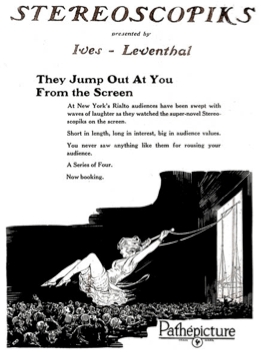 A number of short films were produced in the 1920s and 30s such the Stereoscopiks but they were just novelties. More frequent showings appeared at fairs and in museums.
A number of short films were produced in the 1920s and 30s such the Stereoscopiks but they were just novelties. More frequent showings appeared at fairs and in museums.
Abel Gance shot some scenes for his Napoleon. His notes state:
“To see the rushes, I had to wear those red and green spectacles. The 3D effects were very good, and very pronounced. I remember one scene where soldiers were waving their pistols in the air with excitement, and the pistols seemed to come right out into the audience.”
But he abandoned this plan while moving forward with his idea of a massive three-screen finale.
A variety of shorts and experiments tried to find traction but it wasn’t until 1952 that 3-D really took off with mass audiences.
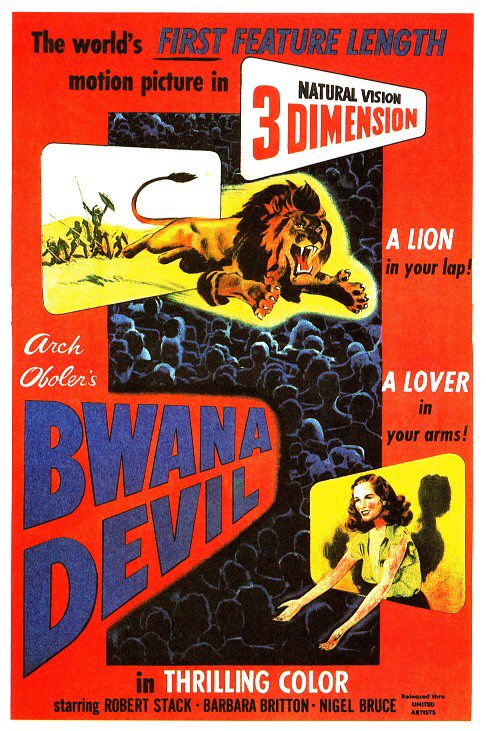
Arch Obler directed Bwana Devil, a mediocre jungle adventure with some good effects. Ironically Oboler was best known for radio dramas where one could close the eyes and imagine the story in any dimensions… especially effective with his horror stories on Lights Out.

 1953 brought a film noir, Man in the Dark, the Vincent Price classic, House of Wax with stereophonic sound as a bonus — and an irony in 3-D history since director Andre de Toth was blind in one eye and could not see the depth effect.
1953 brought a film noir, Man in the Dark, the Vincent Price classic, House of Wax with stereophonic sound as a bonus — and an irony in 3-D history since director Andre de Toth was blind in one eye and could not see the depth effect.
An action western Fort Ti and one of the best 3-D movies of the 1950s, It Came From Outer Space with a script by Ray Bradbury were hits and several more films of varying quality were rushed to the cinemas. But the process was fraught with problems. Two prints had to be projected simultaneously and if one projector was slightly slower than the other or if there was a splice in one print—anything that would throw the showings off by even one frame, it created problems that ruined the 3-D and made audience nauseous. Technical breakdowns and equipment maintenance costs saw most films produced in 3-D for the second half of 1954 go to theaters flat. At Christmas the MGM musical Kiss Me Kate was well received but did better in non-3-D bookings. Films starring John Wayne, Martin & Lewis, Jane Russell and a Rock Hudson western directed by Douglas Sirk plus some science fiction and horror films performed well but by the end of 1954 the novelty was over and the 2-D widescreen presentations were satisfying film goers.
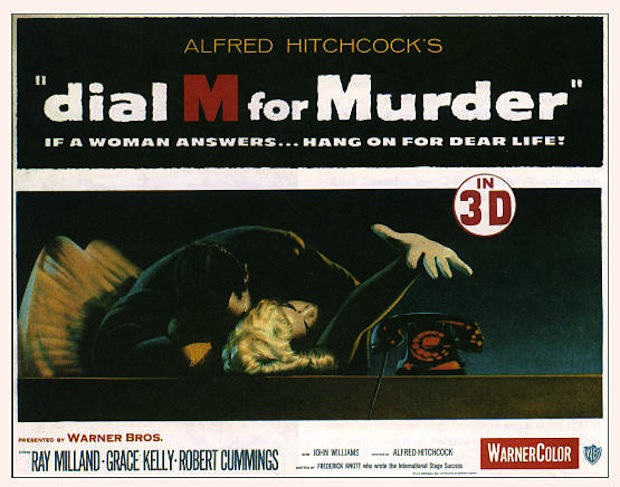 Alfred Hitchcock was reluctant to make a movie in 3-D but bowed to studio pressure. Dial M for Murder had a sneak preview in 3-D and the studio was reportedly thrilled with the reaction though the trade newspaper reviews were mixed, citing the lack of 3-D gimmicks making it more like watching a version of the play it was based on. One scene has Grace Kelly’s arm extended out toward the audience but her scissors face away (the scissors are missing in the ads to avoid a spoiler).
Alfred Hitchcock was reluctant to make a movie in 3-D but bowed to studio pressure. Dial M for Murder had a sneak preview in 3-D and the studio was reportedly thrilled with the reaction though the trade newspaper reviews were mixed, citing the lack of 3-D gimmicks making it more like watching a version of the play it was based on. One scene has Grace Kelly’s arm extended out toward the audience but her scissors face away (the scissors are missing in the ads to avoid a spoiler).
 Otherwise the effect is of rooms with depth but few of the visual thrills audiences expected. For years the story was that Hitch told a Warner Brothers executive audience anticipation of 3-D effects destroyed any chance for true suspense and he did not want it released in 3-D. But recent research by Bob Furmanek proves otherwise. The film did open in Kelly’s hometown of Philadelphia. He writes, “After one preview performance on Tuesday and four showings on the 19th, the manager frantically contacted the studio and said that people were staying away in droves. He asked for permission to drop the 3-D and show it flat.
Otherwise the effect is of rooms with depth but few of the visual thrills audiences expected. For years the story was that Hitch told a Warner Brothers executive audience anticipation of 3-D effects destroyed any chance for true suspense and he did not want it released in 3-D. But recent research by Bob Furmanek proves otherwise. The film did open in Kelly’s hometown of Philadelphia. He writes, “After one preview performance on Tuesday and four showings on the 19th, the manager frantically contacted the studio and said that people were staying away in droves. He asked for permission to drop the 3-D and show it flat.
 On Sunday May 23, a Philadelphia Inquirer headline proclaimed: “Play’s the Thing as Philadelphia Fans Spurn 3-D for 2-D Version of DIAL M.” Mildred Martin wrote: “The first audiences proved to be a jury that could not only make up its mind, but could make it up in a hurry. In exhibitors’ own terms, DIAL M literally died. And after just four performances on Wednesday, some long-distance telephoning to report complaints, the increasing skimpiness of customers–a good many of them making no bones of their dissatisfaction–permission was given to throw away the glasses and hastily switch to the 2-D version. Whereupon business at the Randolph took a turn for the better.” It then became a box office success and in two years the 3-D fad had faded.
On Sunday May 23, a Philadelphia Inquirer headline proclaimed: “Play’s the Thing as Philadelphia Fans Spurn 3-D for 2-D Version of DIAL M.” Mildred Martin wrote: “The first audiences proved to be a jury that could not only make up its mind, but could make it up in a hurry. In exhibitors’ own terms, DIAL M literally died. And after just four performances on Wednesday, some long-distance telephoning to report complaints, the increasing skimpiness of customers–a good many of them making no bones of their dissatisfaction–permission was given to throw away the glasses and hastily switch to the 2-D version. Whereupon business at the Randolph took a turn for the better.” It then became a box office success and in two years the 3-D fad had faded.
In 1979 revival theater owners convinced Warners to make new 3-D prints of Dial M for Murder and it was a huge success that resulted in many play dates. As if to reverse the past, the ad campaign promoted new improved glasses.
Arch Obler introduced a single projector system called Space-Vision 3-D in 1966 with his film The Bubble ( hyperlink Amazon EDF ). It was simple to project with no worries about the two prints going out of synch while the cost of prints and presentation were relatively inexpensive. The film was a success for a new generation but the system mostly became useful for X-rated films with The Stewardesses and Andy Warhol’s Frankenstein (aka Flesh for Frankenstein) being the most notable.
When I programmed the Nuart Theatre in Los Angeles we booked a triple XXX film starring the legendary John Holmes for midnights with the ad stating “Duck—John Holmes is Cummin’ at You!” The Pasadena Courier wrote “3-D is what makes the film a riot. One can’t help but crack-up at the various body parts that appear to be jiggling, bouncing, dangling and squirting off the screen.”
 The early 80s brought a new rash of bad studio attempts to cash in on three dimensions. Looking for any gimmick, unnecessary sequels made Jaws III into Jaws 3-D and the inevitable Amityville 3-D. To make sure we were clear on the concept, there was Friday The 13th Part III: 3D – A New Dimension in Terror. But this round lasted only a few years.
The early 80s brought a new rash of bad studio attempts to cash in on three dimensions. Looking for any gimmick, unnecessary sequels made Jaws III into Jaws 3-D and the inevitable Amityville 3-D. To make sure we were clear on the concept, there was Friday The 13th Part III: 3D – A New Dimension in Terror. But this round lasted only a few years.
By the mid 1980s IMAX was looking for something to reinvigorate their business and 3D was the answer. They made non-fiction mid-length movies often creating a repertory of titles with different shows every hour.
In 2004 the popular children’s book The Polar Express was made into a film by Robert Zemekis. It was a kind of creepy looking film featuring humans animated from live action motion capture. While playing in 2-D in over 3500 theaters and only 66 IMAX 3D engagements, the later represented 25% of the total box office. Seeing the movie that way was a revelation and showed what the future of the medium could be. Within a few years more high profile, big budget 3-D movies were released to great success. The most consistent genre was animated family films but ironically small children have trouble keeping the glasses on and seeing the entire screen so parents tend to take them to less expensive 2-D showings. AVATAR was a game changer and now few science fiction and fantasy films are not made in 3-D. Only a couple of straight dramas have played with the format, The Great Gatsby being a rare exception. I am still waiting for some wonderfully visual slapstick to jump off the screen as happened in the 1950s when there were two 3-D 3 Stooges shorts released.
A few art films have been successful, especially Wim Wenders’ beautiful Pina about the dancer Pina Bausch and Werner Herzog’s stunning mediation of prehistoric cave drawings, Cave of Forbidden Dreams. Jean-Luc Godard’s current Goodbye to Language is a playful experiment with the format. I have also seen the upcoming Cathedrals of Culture a collection of six short films about architecture and “the soul of buildings.” Directed by Wim Wenders, Robert Redford, Karim Ainouz and three other international directors it is an uneven but worthy experience.
3-D in the movies is here to stay but most multiple screen theaters offer a choice to buy glasses or watch it the old-fashioned way. It will be interesting to watch what kind of theatrical movies will continue to be made in the format.
3-D television has not taken off, partially because of the expensive TVs and glasses. Maybe those who want the experience prefer it on a huge screen—for total immersion. I predict that when 3-D television without glasses arrives, it will all change, especially for sports.
GOING DEEPER – part two
For those of you wanting to know even more, there are some articles that give greater detail and more illustrations.
While Reading any of these articles you will enjoy Ray Martin’s homage to big screen movies on The Sounds of Sight.
 Everywhere You Look – surrounded by projected films
Everywhere You Look – surrounded by projected films
What is Circle-Vision 360° ?
Bigger Than Life – New screen formats.
Cinema Expo 67-the film formats.
A Place to Stand– the Canadian multiple image 20 minute short
 Read about The Labyrinth Project and watch In The Labryinth , the third part of the Expo ‘67 Labyrinth exhibit at the fascinating “Instant Cinema” site
Read about The Labyrinth Project and watch In The Labryinth , the third part of the Expo ‘67 Labyrinth exhibit at the fascinating “Instant Cinema” site
Read about Kino-Automat and watch the trailer.
Here’s an excellent overview of the adventurous film formats at Expo ‘67.
All about IMAX.How regular movies become IMAX films.
Douglas Trumbull on what he thinks is the future of cinema on the eve of revealing his new format Magi with his short film UFOTOG.
Douglas Trumbull discusses increased frame rates in digital Showscan in this interesting video (scroll down to see the video).
Sensory Assault: Dolby Takes on Imax with Mega-Theater Rival.
Dolby’s Site Explains it Further
Classic 3-d Movies
What Can Paul Allen’s Millions Do To Save a Single Screen Movie Theatre?
Tommy Can You Hear Me? – Sound
A History of Stereophonic Sound.
A History of Dolby.
Dolby Laboratories site.
What is THX?
THX official site.
Meyer Sound sets new standards for sound.
When you go out for a meal most people want three things: Great food, terrific service and _________________?
I think it is to be able to comfortably talk with your dinner companions. Meyer Sound has now created Constellation, a sophisticated combination of algorithms, small speakers and microphones that makes it easy to hear everyone in your party. Locally the initial restaurants to thrill diners are Berkeley’s Comal and the just renovated Oliveto in Oakland. Owners Bob and Maggie Klein want their patrons to be relaxed and never again to be leaning forward straining to hear or be heard.
In Your Face and In Your Lap — 3D
A Short History of 3-D
The director of Bwana Devil first produced radio dramas. Listen to Arch Oboler’s Chicken Heart , or The Dark with your eyes closed or in a very dark room for a frightening sound experience. Your mind provides the 3-D.
Arch Obler Collection of Horror Radio Shows
3-D Film Archive is lots of fun with old ads, trailers and some 3-D—get your red/green glasses out.
Ray Zone wrote excellent books on 3D cinema.
Other 3D books
3-D Movies: A History and Filmography of Stereoscopic Cinema
Detailed history of Dial M for Murder
David Bordwell on the 3-D version of Dial M for Murder.
 Gary Meyer co-founded Landmark Theatres in 1975, the first national arthouse chain in the U.S. focused on creative marketing strategies to build loyal audiences for non-Hollywood fare. After selling Landmark, he consulted on projects for Sundance Cinemas and the Brooklyn Academy of Music’s Rose Cinemas, created the Dockers Classically Independent Film Festival and Tube Film Festival for the X Games, and resurrected the 1926 Balboa Theatre in San Francisco. Meyer joined the Telluride Film Festival in 1998, becoming a Festival Co-Director in 2007. Meyer also founded the online magazine, EatDrinkFilms.com in 2014, with the EatDrinkFilms Festival to tour nationally in 2015.
Gary Meyer co-founded Landmark Theatres in 1975, the first national arthouse chain in the U.S. focused on creative marketing strategies to build loyal audiences for non-Hollywood fare. After selling Landmark, he consulted on projects for Sundance Cinemas and the Brooklyn Academy of Music’s Rose Cinemas, created the Dockers Classically Independent Film Festival and Tube Film Festival for the X Games, and resurrected the 1926 Balboa Theatre in San Francisco. Meyer joined the Telluride Film Festival in 1998, becoming a Festival Co-Director in 2007. Meyer also founded the online magazine, EatDrinkFilms.com in 2014, with the EatDrinkFilms Festival to tour nationally in 2015.

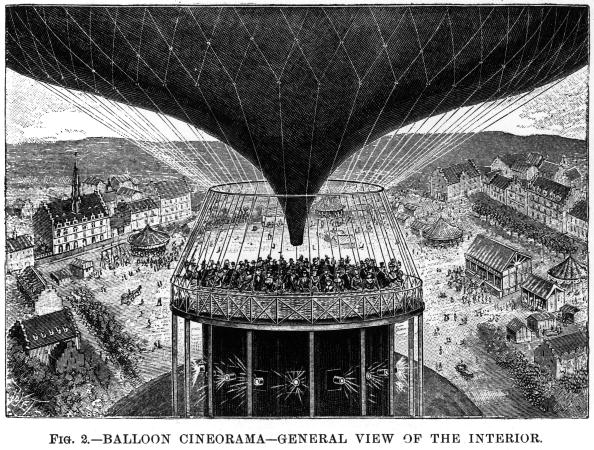

![Labryrinth at Expo ’67]](https://eatdrinkfilms.com/wp-content/uploads/2014/12/labyrinth-expo.jpg?w=670)
